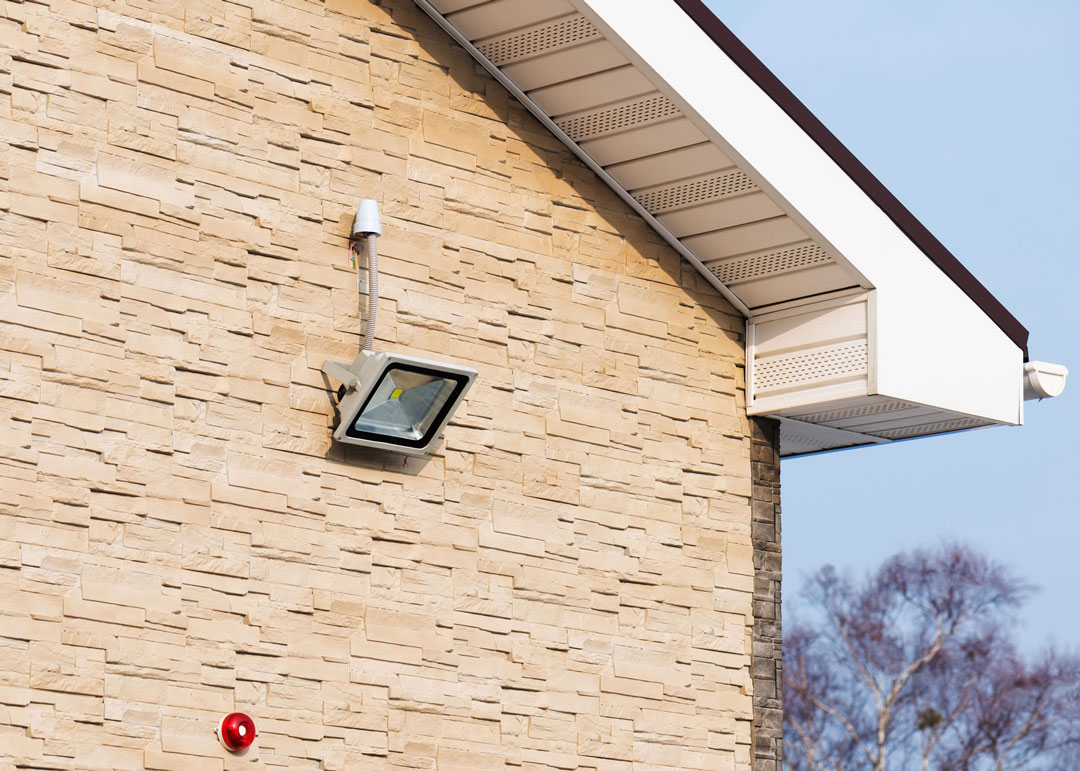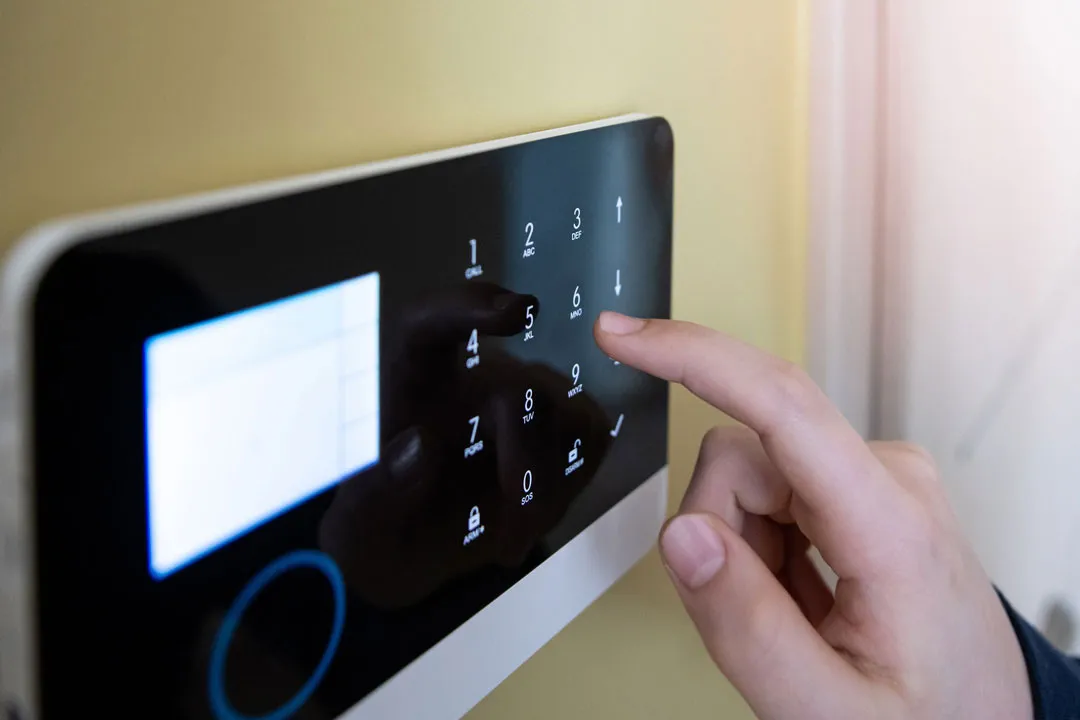How to secure your home?
The summer months are now behind us and we look back with nostalgia at the long, warm, sunny days, especially now that the days are getting colder and shorter. What we would rather forget are the stories of (attempted) burglaries that may have been going around your neighbourhood. Thieves who had free rein while you were sunbathing at the beach or having a barbecue in the mountains. Even though the days are getting darker, the security of your home is still an important concern. What short-term measures can you take to secure your home?

-
Floodlights
Floodlights, also known as construction lights, offer a relatively inexpensive solution and, thanks to an integrated sensor, immediately bring thieves to attention. The sensors usually have a range of several metres, which means that the slightest movement immediately activates the lamp. Floodlights are known for their long range. Therefore, one spotlight is often enough to illuminate the entire garden, for example. Nowadays, they are available in LED versions, which makes this type of lighting much more economical than its conventional halogen counterpart.Thanks to their frame, you can also tilt them to obtain the desired beam angle.
Check out the range of floodlights from our partner MyPlanetLed here:
https://www.myplanetled.com/nl/buitenverlichting/bouwlamp/

2. Security cameras
Do you want to put the spotlight on burglars and keep track of them on video? Security cameras are the solution of choice, whether or not in combination with floodlights. You need to invest in a few things to do this:
- NVR : Network Video Recorder. Il s'agit du disque dur sur lequel sont stockées vos images. Les NVR modernes ont un logiciel intégré qui vous permet de tout surveiller ou de tout lire via votre ordinateur portable ou votre smartphone.
- La caméra elle-même : les caméras de sécurité existent en de nombreuses versions, tailles, complexités, etc. Dans un environnement domestique, nous trouvons principalement des caméras bullet et des caméras dôme. Les caméras bullet ont l'avantage d'un angle et d'une portée plus larges, mais se distinguent davantage par leur forme. Les caméras dômes, quant à elles, sont plus discrètes. Vous obtenez l'installation la plus stable en travaillant avec des caméras câblées. Ils obtiennent à la fois la connexion internet et l'alimentation via le même câble (technologie POE, voir ci-dessous).
- Commutateur POE : POE est l'abréviation de Power Over Ethernet (alimentation par Ethernet). Il s'agit de la technologie utilisée pour alimenter les caméras via le câble Internet. Il existe à cet effet des commutateurs qui connectent et alimentent la caméra en données Internet ainsi qu'en électricité. Cela permet à la caméra de communiquer avec le NVR et l'utilisateur afin que les images puissent être visualisées et stockées.
Aujourd'hui, il existe également des caméras qui peuvent être installées sans câblage. Ces modèles ne nécessitent qu'une alimentation électrique et une connexion sans fil. Avec ces modèles, cependant, vous dépendez de la portée de votre signal sans fil et de la vitesse de votre WiFi.
3. Systèmes d'alarme
Avec 34 000 cambriolages par an dans notre pays, un système d'alarme n'est certainement pas un luxe de nos jours. Saviez-vous qu'un système d'alarme peut également ajouter de la valeur à votre maison et qu'il n'est pas nécessaire d'être très cher pour en acheter un ? Avec les nouvelles technologies, de plus en plus de systèmes d'alarme arrivent sur le marché. Du bon marché au très cher, du simple au complexe. Voici un bref aperçu des options les plus courantes.
- A simple system.
With the alarm system, a motion sensor detects your movements when you enter the house and activates the system, sending an acoustic signal inside and outside the house. This signal alerts the surroundings and deters intruders. An additional light outside makes it even more obvious that the alarm has been triggered. The system is simply efficient and easy to use. These systems are available in almost all hardware stores, with clear instructions for use. The installation of such a system is very easy if you follow the instructions correctly.
- Complete alarm system.
The alarm system can also be connected to a central alarm station. The alarm centre then calls in a security company. These alarm centres are often part of security companies. The security guards check your house to see if something is really wrong or if it is a false alarm. This gives you direct control and this knowledge gives a sense of calm and familiarity. Of course, this form of security is more expensive than a simple alarm system, but the added value makes the extra investment worthwhile.
- Advanced alarm system.
Alarm systems were originally designed to prevent intruders, but today's alarm systems have been enriched with several features that add value to the system. The sensor not only detects movement, but also fire. In this way, the alarm system functions as a fire alarm system and, by connecting to the alarm control centre, it can respond quickly to an alarm. The sensor can also be equipped with a camera to create images directly on the control panel. As these systems develop, so do their applications.
- Deployment of WLAN and telephony
Alarm system manufacturers like to make use of the extensive possibilities of the Internet and wireless telephony. An alarm system can be deployed efficiently by having different components such as sensors and detectors communicate with each other. In addition, using your mobile phone, you will always be informed immediately of any alarm notification. This makes the alarm system more efficient and significantly improves its performance. Furthermore, as the situation can be spotted at an early stage, there is the advantage that there are few false alarms. It is always good to avoid unnecessary emergency services.
Which configuration is best for me?
To answer this question, two options are important:
- Wired, wireless or hybrid?
The first thing to choose is the type you want. The quality between the above types is practically non-existent. A disadvantage of wireless systems, for example, is the need to replace batteries from time to time. If the cables are already present, we recommend that you opt for wired systems. Otherwise, we recommend the wireless version. Laying cables involves demolition work. If there are already cables in the building but they do not run through critical points, we recommend a combination of wired and wireless. With a hybrid system, you get the best of both worlds. The system is easy to expand, for example for wireless camera surveillance.
- Basic or extended system
After answering the first question, you can choose a basic or advanced system. The basic package includes a control panel, a siren and a set of motion sensors. With an extended system, you get everything that comes with the basic package + remote control, window magnets and connection to the alarm centre. Finally, you can also choose smoke detectors or carbon monoxide detectors. Nowadays you can also choose fog generators to prevent thieves from seeing anything, for example.

